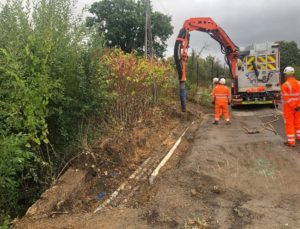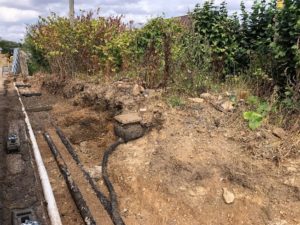
Strategy Overview: Mechanical Remediation Strategy – Excavation (via vacuum excavation) and off-site disposal, with provision of membrane barrier.
JKSL were instructed to assess the extents of Japanese knotweed on the A44, Wolvercote, and to provide an appropriate remediation strategy to facilitate development which included the construction of a bus lane and cycle lane.
During JKSL’s initial inspection, horsetail was also recorded within the footprint of the development. Although horsetail is native, it is still considered to be invasive, with it causing potential defects to hardstanding areas (such as tarmacadam pavement, driveways, cycleways etc) when present in high plant numbers.
Due to the proposed development directly affecting the Japanese knotweed (and horsetail), a mechanical remediation strategy option was required to be implemented whereby the associated impacted material is excavated/removed, to ensure the problem was not exacerbated further by spreading propagules (i.e. a vegetative structure that can become detached from the main plant and give rise to a new plant) around site and off-site, and to minimise the risk of future defects on the proposed hardstanding areas.
Due to limited space on site, the excavated impacted material was disposed off-site at an appropriate licenced facility (i.e. could not be retained on site).
Excavation extents were restricted due to the presence of services in the proposed dig (included BT, other communications, gas, water and electric). JKSL completed the works in accordance with HSG47 and safe digging practices.


What we did
A vacuum excavator (vac ex) was used during the works to excavate the impacted material. Biosecurity control measures were implemented to prevent propagules being spread around site (and off-site). For example, the vac ex was only ever situated on “clean” areas, so its wheel were not in direct contact with impacted material during the excavation process (thus reducing risks of spreading propagules around site).
Prior to the collection of the excavated impacted material via grab wagon (i.e. before onward disposal at an appropriate licenced facility), the excavated impacted material was tipped from the vac ex onto a temporary waste management area/TWMA which was lined with a temporary membrane barrier, prior to onward disposal.
Upon completion of the excavation works, the vac ex was decontaminated, which also involved cleaning/washing the main skip compartment situated within the vac ex with a jet wash. The spoil (containing potential impacted material) from this process was captured on a porous membrane, within the TWMA, which was then dispose off-site along with the other previously excavated impacted material. The filters on the vac ex were also removed on site, so that they could be washed through with water within the TWMA, again removing potential spoil containing potential impacted material. The filters were situated quite high up on the vac ex, so a platform mounted vehicle was used to facilitate the initial removal/placing back of the filters; there were circa 17 removable filters on the vac ex to clean, so this wasn’t a quick process!
Due to excavation extents being restricted due to the presence of services (as mentioned above), a reduce-level-dig was undertaken within the dig area. An appropriate membrane barrier was installed to contain underlying propagules and to prevent re-growth emerging in the development footprint. A capping layer (with appropriate clean material) was then installed on top of the barrier. It is JKSL’s understanding that there is already an existing monitoring and treatment programme (being undertaken by another contractor) to reduce the viability and control the viability of Japanese knotweed (and horsetail) surface growth situated beyond the membrane barrier (which isn’t directly affected by the development footprint).

